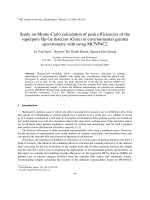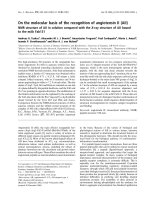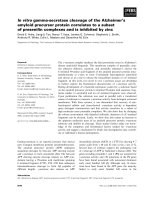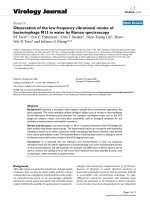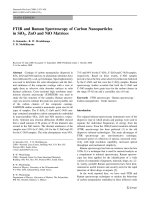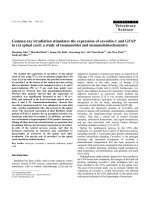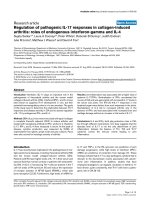In beam gamma ray spectroscopy of 63,65Cr
Bạn đang xem bản rút gọn của tài liệu. Xem và tải ngay bản đầy đủ của tài liệu tại đây (683.77 KB, 9 trang )
IN-BEAM GAMMA RAY SPECTROSCOPY OF 63,65Cr
N. D. Ton1, A. Corsi2, L. X. Chung1, A. Gillibert2, B. D. Linh1, A. Obertelli2,3, and P. D. Khue1
1. Institute for Nuclear Science and Technology, 179 Hoang Quoc Viet, Hanoi, Vietnam
2. Institute of Researchinto the Fundamental Laws of the Universe (IRFU), CEA Saclay, France
3. Institut für Kernphysik, Technische Universität Darmstadt, 64289 Darmstadt, Germany
Email:
Abstract: The neutron-rich nuclei 63,65Cr were produced at the RIBF facility at RIKEN in
the first campaign of the “Shell Evolution And Search for Two-plus energies At RIBF”
(SEASTAR) project. The preliminary results of in-beam gamma ray spectroscopy of
these nuclei, the detail of experimental setup and the particle identification method are
presented. Based on the analysis, new gamma ray transitions were observed at 420, 580
and 730 keV for
63
Cr, 392 and 489, 720 keV for
65
Cr, respectively. They are the first
experimental results on these nuclei.
Key words: SEASTAR, 63Cr, 65Cr, particle identification, gamma ray transition.
I. Introduction
Since last years of the 20th century, research on exotic nuclei began being concerned with
the most advanced experimental method which aimed at measuring the products of reactions
induced by radioactive isotope beams (RIBs) produced by projectile fragmentation and fission of
heavy ion beams. The research with RIBs was mainly carried out in big laboratories worldwide
equipped with the most advanced facilities such as the RIBF at RIKEN (Japan), the LISE3 at
GANIL (France), A1900 at MSU (US) and the FRS at GSI (Germany) [1-4]. Since the
availability of RIBs, shell structure of exotic nuclei has been studied and many new phenomena
which beyond the explanation of shell model were explored: neutron skin and halo structure [5,
6], appearance of new magic numbers [7] such as neutron number N = 32, 34 [8, 9], a new
“island of inversion” at N = 40 [10-12] or disappearance of the magic numbers N = 28 [13].
The “Shell Evolution And Search for Two-plus energies At RIBF” (SEASTAR, RIBFRadioactive Isotopes Beam Factory) project aims at a systematic search for new
energies in
the wide range of neutron-rich nuclei [14]. By using 70Zn and 238U primary beams at 345 MeV/u
in combination with advanced devices, many new isotopes were produced and detected. From
the spectroscopic analysis, properties of shell structure of these nuclei can be extracted. The
neutron–rich nuclei 63, 65Cr were recorded at the first SEASTAR campaign. With neutron number
N= 39 and 41, studies on
63, 65
Cr will directly contribute to the knowledge and understanding of
the “island of inversion” N = 40 at low - Z shore. In this report, experimental setup of this
SEASTAR project and preliminary spectra of 63, 65Cr will be presented, besides that, the analysis
of these spectra, including the transition identification, fitting spectra are also discussed.
II. Experimental setup
The first SEASTAR experimental campaign was performed in 2014 at RIBF/RIKEN with
the combination of the MINOS [15, 16] active target and array detector DALI2 [17, 18]. A
238
U
primary beam was accelerated up to energy of 345 MeV/u by the RIBF acceleration system before
impinged on a 9Be primary target at the F0 focal plane of the BigRIPS separator [19, 20].
Afterward, the secondary beam – products of fragmentation reactions between primary beam and
9
Be target was identified, separated by the BigRIPS detection system before being
Figure 1. Scheme of SEASTAR’s experimental setting. The label Fn are indicate the position of
focal planes. The BigRIPS is from F0 to F7 and ZeroDegree is from F8 to F11.
transported to the user locations and interacted with the MINOS proton target at the F8 focal
plane. While residual nuclei after the reactions were identified by ZeroDegree [20, 21], excited
gamma rays of these nuclei were recorded by DALI2. The schematic layout of the SEASTAR
experimental setup is shown in Fig. 1.
During the SEASTAR experiments, particle identification of secondary beams was
performed in event-by-event mode at the BigRIPS based on Bρ - ΔE - ToF method. The BigRIPS
is a two-stage separator from F0 to F7: the first stage is from F0 to F2 used for producing,
collecting and separating the RIBs; while the second stage is from F3 to F7 used for particle
identification (PID) and/or further separating, optimizing the nuclei of interest via the magnetic
optimization. At each focal plane of the BigRIPS, PID parameters including energy loss (ΔE),
magnetic rigidity (Bρ) and time of flight (ToF) were measured by MUSIC, PPAC and plasticscintillation detectors, respectively. For these measurements, there were two thin plasticscintillation detectors placed at F3 and F7, three double-PPACs [22] placed at F3, F5 and F7 and
only one MUSIC detector [23] placed at F7 (see Fig. 1). After the optimization, beam of interest
was transported to F8, impinged on the MINOS target at 200 – 300 MeV/u of energy. Then,
produced neutron-rich nuclei were produced by scattering or knock-out reactions. The MINOS is
an active target including of 2 components: A liquid hydrogen (LH2) volume playing the role of a
reaction target and a Time Projection Chamber (TPC) used for the vertex reconstruction and
tracking purpose. After creating at the MINOS target, the residual nuclei decay into more stable
states by releasing gamma rays while traveling at kinetic energy of about 200 - 270 MeV/u. These
in-beam gamma rays were recorded by DALI2. Outgoing particles were identified by ZeroDegree
spectrometer which was installed from F8 to F11. At the ZeroDegree, particles were identified
event-by-event basing on Bρ - ΔE – ToF method, similar to that at BigRIPS. For the measurement
of PID parameters, a MUSIC detector was installed at F11, two thin plastic scintillators located at
F9 and F11, and three double-PPACs located at F8, F9, F11.
In the next section, the data analysis procedure and its preliminary results will be
discussed.
III. Data Analysis and results
63, 65
Cr were obtained from the first SEASTAR experimental campaign focusing on the
spectroscopy of 66Cr, 70, 72Fe and 78Ni. In this part, the reconstruction of the variables of events of
interest from the recorded data will be described. Firstly, the particle identification is performed to
specify the reaction channel of interest. Secondly, the MINOS detector will be calibrated to
reconstruct the trajectory of knock-out protons and obtain vertex positions of knock-out reactions.
Beside the DALI2 array will be also calibrated in energy. Thirdly, the DALI2 response functions
to gamma energy will be simulated and used for fitting gamma rays spectra.
3.1. Particle identification
As mentioned before, the PIDs were performed at BigRIPS/ZeroDegree and its results are
used for selecting the reaction channel of interest. Incoming/outgoing particles are identified from
F3 to F7 of BigRIPS and from F8 to F11 of ZeroDegree, respectively. The PID is based on Bρ ΔE - ToF method [20]. Where, Bρ is magnetic rigidity and could be achieved via the trajectory
reconstruction while ΔE and ToF are energy loss and time of flight, respectively, and could be
obtained via direct measurements. At the BigRIPS, the trajectory reconstruction was performed by
using 3 double-PPACs at F3, F5 and F7. Two thin plastic detectors at F3, F7 were used for time of
flight (TOF) measurement. The energy losses (ΔE) were measured by MUSIC at F7. Similarly, the
ZeroDegree spectrometer used a MUSIC detector at F11. Two thin plastic scintillators at F9, F11
were used for (ΔE) and (TOF) measurements. The trajectory reconstruction at the ZeroDegree was
performed by using 3 double-PPACs at F8, F9 and F11. By using the energy loss, time of flight
and magnetic rigidity, atomic number (Z) and mass-to-charge ratio (A/Q) of particle are deduced
as:
B
P
B c ,
A Q
Q
mu
TOF
L
,
c
2me v 2
dE 4 e4 Z 2
E
Nz ln
ln(1 2 ) 2 .
2
dx
me v
I
(2.1)
(2.2)
(2.3)
Where, TOF, B, ρ and ΔE are the time of flight, magnetic field, the radius of the particle’s
tracjectory and energy loss, respectively. L is the flight-path length, υ is particle velocity, β = υ/c,
c is the light velocity, γ = 1/, mu = 931.494 (MeV) is the atomic mass unit, me is the electron mass
and e is the elementary charge. N, z and I are the atomic density, atomic number and mean
excitation potential of the material. Z, A, P and Q represent the atomic, mass, momentum and
charge number of the particle, respectively. In order to improve the PID resolutions at the
ZeroDegree, some corrections are required (Fig. 3). The PID procedures at the BigRIPS and
ZeroDegree as well as the PID correction at the ZeroDegree have been already described in detail
on preference [24]. Figure 4 shows the PID results in BigRIPS and ZeroDegree
63,65
Cr are marked
in the right panel.
Figure 2. Particle identifications via the correlation A/Q versus Q at the BigRIPS (left) and
ZeroDegree (right). At the BigRIPS, events of exotic nuclei from Cr to Ni are showed and
incoming-particle of interested channels are marked. At the ZeroDegree, events of exotic nuclei
from Cr to Ni are showed. Events of 63, 65Cr are marked.
3.2 Gamma spectra of 63, 65Cr
As noted previously, because of statistical limitation, only spectra of
channel
64+X
Mn(p,2pXn)63Cr (X = 1, 3) and spectra of
(Y = 0, 1) will be showed. Note that
63, 65
65
Cr populated from
63
Cr from reactions
65+Y
Mn(p,2pYn)65Cr
Cr emitted gamma rays during flight, the energies of
these gamma rays were shifted. The shifted energy is dependent on the emitted angle and the
velocity of the residual nucleus. The angle was determined by using the vertex position. The
gamma energy was corrected for the Doppler broadening as:
EDopp E
Where,
1 cos
1 2
is the energy of the gamma ray after corrected,
(3.1).
is the energy recorded by
DALI2, β is the beam velocity at the vertex position and θ is the gamma emitted angle with respect
to the beam direction. The angle is calculated by using vertex point and position of DALI2 crystal
fired by the emitted gamma because each DALI2 crystal was located at a certain position in the
space. After the correction, gamma spectra were fitted with a function being a sum of the DALI2
response function simulated with SHOGUN package [25] and a background of an exponential
function. A transition is accepted if its width agree with the expected resolution (i) and its intensity
obtained from the fit must be at least twice greater than its statistical uncertainty (ii).
Figure 3. Doppler corrected spectra of
(panel a) and
67
63
Cr populated from reaction channels
65
Mn(p,2pn)63Cr
Mn(p,2p3n)63Cr (panel b). Black are fitting curves. Red-smooth curves are the
DALI2 simulating responses to the gamma energies indicated in the plot. Red- dash line is the
background function.
The gamma spectra of 63Cr populated from 65Mn(p,2pn)63Cr and 67Mn(p,2p3n)63Cr reactions
are shown in Fig. 3. They contain the same 3 transitions at 420 and 580 and 730 keV. The gamma
transition at 420 keV has been previously reported via beta decay of 63V into 63Cr [24].
Figure 4. Doppler corrected spectra of
67
65
Cr populated from
66
Mn(p,2p)65Cr (panel a) and
Mn(p,2pn)65Cr (panel b). Black are fitting curves. Red-smooth curves are the DALI2 simulating
responses to the gamma energies indicated in the plot. Red- dash line is the background function.
The gamma spectra of
63
Cr populated from
66
Mn(p,2p)65Cr and
67
Mn(p,2pn)65Cr reactions
are presented in Fig. 4. Gamma transitions at 413, 520 and 692 keV are observed in (p,2p)
reaction. Meanwhile, the transitions at 392, 489 and 714 keV are observed in (p,2pn) reaction.
IV. Conclusion
This work presents an overview of the SEASTAR experimental setup and preliminary
results of data analysis including the PID at BigRIPS /ZeroDegree and gamma spectra of 63, 65Cr.
Based on the analysis gamma spectrum, new transitions of these nuclei were observed. Besides
that, the PID principle at the BigRIPS/ZeroDegree and the operation of MINOS and DALI2 were
presented.
In the next step, the theoretical predictions for
65, 65
Cr structures should be performed in
order to interpret the experimental results. This is also used to place the observed transitions in
the level scheme of these nuclei.
The Vietnamese authors would like to thank MOST for the support under Grant Nos. ĐTCB
09/17/VKHKTHN.
References
[1] T.Kubo, Nucl. Instr. Meth. B 204, (2003), pp. 97-113.
[2] A.C, Nuclear Instrum. And Methods Phys. Res B 56, (1991), pp. 559-563.
[3] D.J. Morrissey et al., Nuclear Instrum. And Methods Phys. Res B 204, (2003), pp. 90-96.
[4] H. Geissel et al., Nuclear Instrum. And Methods Phys. Res B 70, (1992), pp. 286-297.
[5] I. Tanihata, J. Phys. G 22, (1996), 157, and references therein.
[6] L. X. Chung et al., Physical Review C 92, (2015), 034608.
[7] O. Sorlin et al., Progress in Particle and Nuclear Physics 61, Issue 2 (2008) 602-673.
[8] D. Steppenbeck et al., Nature 502, 207 (2013).
[9] G. Hagen et al., Phys. Rev. Lett. 109, 032502 (2012).
[10] J. Ljungvall et al., Phys. Rev. C, 81:061301, 2010.
[11] W. Rother et al., Phys. Rev. Lett., 106:022502, 2011.
[12] H. L. Crawford et al., Phys. Rev. Lett., 110:242701, 2013.
[13] B. Bastin et al., Phys. Rev. Lett. 99, 022503 (2007).
[14] Pieter Doornenbal and Alexandre Obertelli, RIBF NP-PAC-13 (2013).
[15] A. Obertelli et al.,Eur. Jour. Phys. A 50, 8 (2014).
[16] A. Obertelli and T. Uesaka, Eur. Phys. J. A 47, 105 (2011).
[17] P. Doornenbal, Prog. Theor. Exp. Phys., 03C004, (2012).
[18] S. Takeuchi et al., Nucl. Instr. Meth. A 763 (2014) 596.
[19] ToshiyukiKubo, Nucl. Instr. Meth. B 204 (2003) 97.
[20] N. Fukuda et al., Nucl. Instr. in Phys. Res. B 317, 323 (2013).
[21] T. Kubo et al., Prog. Theor. Exp. Phys., 03C003, (2012).
[22] H. Kumagai et al., Nuclear Instrum. And Methods Phys. Res., Sect. A 470, (2001), 562-570.
[23] K. Kimura et al., Nuclear Instrum. and Methods Phys. Res., Sect. A 538, (2006), 608.
[24] B. D. Linh, N. D. Ton, L. X. Chung et al., Nuclear Science and Technology, Vol.7, No. 2
(201 7), pp. 08-15
[25] P. Dornenbarn, SHOGUN simulating package based on Geant4 toolkit for DALI2 response
function to gamma energies, unpublished
[26] S. Suchyta et al., Phys. Rev. C, 8: 034317, 2014.
PHỔ GAMMA PHÁT XẠ TRÊN ĐƯỜNG BAY CỦA 63, 65Cr
N. D. Ton1, A. Corsi2, L. X. Chung1, A. Gillibert2, B. D. Linh1, A. Obertelli2,3, and P. D. Khue1
1. Institute for Nuclear Science and Technology, 179 Hoang Quoc Viet, Hanoi, Vietnam
2. Institute of Researchinto the Fundamental Laws of the Universe (IRFU), CEA Saclay, France
3. Institut für Kernphysik, Technische Universität Darmstadt, 64289 Darmstadt, Germany
Email:
Tóm tắt: Các hạt nhân khơng bền giàu neutron 63,65Cr được tạo ra trên hệ thống RIBF của
viện nghiên cứu RIKEN trong chiến dịch thí nghiệm thứ nhất của dự án nghiên cứu cấu
trúc các hạt nhân giàu neutron (SEASTAR). Trong báo cáo này, kết quả ban đầu về phổ
gamma tức thời của các hạt nhân
63,65
Cr cũng như chi tiết về cấu hình thí nghiệm và
phương pháp nhận diện hạt của dự án SEASTAR được trình bày. Thơng qua phân tích,
chúng tơi quan sát được các chuyển dời gamma có năng lượng 420, 580 và 730 keV của
Cr, 392 và 489, 720 keV của 65Cr. Đây là các kết quả thực nghiệm đầu tiên của các hạt
63
nhân này.
Từ khóa: SEASTAR, 63Cr, 65Cr, nhận diện hạt.
